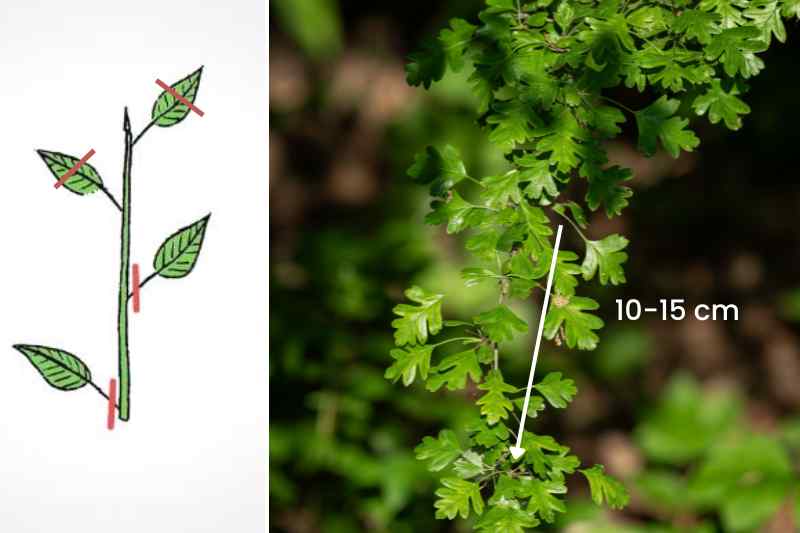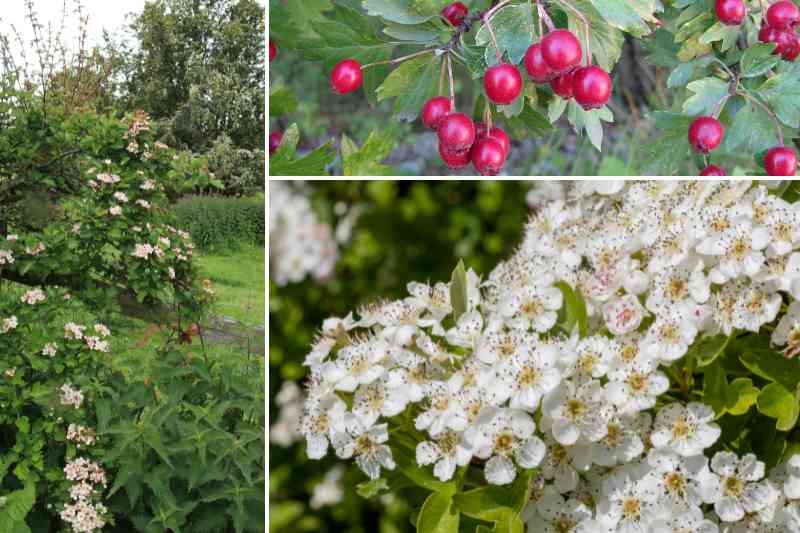- Harvest seeds: collect hawthorn fruits in autumn once fully ripe (slightly soft). Extract seeds and clean them thoroughly.
- Seed stratification: hawthorn seeds require cold stratification to germinate. Place seeds in damp sand and leave them in fridge for about three months.
- Sowing: sow stratified seeds in autumn or spring, in a mix of compost and sand. Cover with a thin layer of growing medium and keep moisture constant.
- Monitoring and planting out: seedlings appear after a few months. Once well developed, they can be transplanted to open ground.
Please note: letting nature take its course also works very well. Birds eat hawthorn fruits, the haws, then disperse them widely. Seeds will then germinate and young plants will appear here and there. All that remains is to move them to desired location.
How to propagate hawthorn by cuttings?
- Take cuttings: choose semi-ripe shoots, i.e. current-year shoots starting to harden. Cut segments 10–15 cm long, taking care to remove leaves from base.
- Plant cuttings in a light medium, made of equal parts sand and compost.
- Place cuttings in a bright spot, sheltered from direct sun. Maintain constant moisture by watering regularly and covering pots with plastic film or placing them in a mini greenhouse.
- After 6–8 weeks, roots should appear. Once well rooted, cuttings can be planted out in open ground the following spring.

Hawthorns, or Crataegus, are bushes or small trees belonging to family Rosaceae. Highly prized in gardens for beautiful spring flowering, this bush bears white or pink flowers followed by small red fruits, the haws. Hawthorn is also appreciated for its hardiness and ability to adapt to different types of soil. Hardy to cold and disease, it can be grown both as a hedge and as an isolated specimen. In short, it is an excellent bush worth propagating. Shall we see how in this how-to sheet?
The world of hawthorns is wide and interesting! To learn all about them, read Hawthorn, Crataegus: planting, pruning and care.

Why propagate hawthorn?
Propagating hawthorn not only provides new young plants at low cost, for a hedge for example, but also helps preserve a particular variety or species you especially appreciate.
Equipment needed
- A pruning shear that is sharp and disinfected
- Pots or a seed tray
- A light growing medium, made from sand and compost, such as a seed compost
- A watering can with a fine rose
- A mini greenhouse (facultative)
When to propagate hawthorn?
The best time to propagate hawthorn depends on chosen technique.
Propagation by cuttings is generally practised at end of summer, when young shoots begin to lignify. Sowing, meanwhile, is done in autumn, after seed harvest. Layering, another possible technique, can be carried out in spring or autumn.
Different propagation techniques
- Sowing: involves harvesting seeds in autumn, cold-stratifying them for three months, then sowing in a light medium for spring germination;
- Cuttings: take semi-ripe shoots at end of summer, plant them in a light medium kept moist until rooting;
- Layering: this technique involves bending a low branch to the ground, making a slight incision, partly burying it and letting it develop roots before separating it from mother plant;
- Graft: mainly for professionals, hawthorn grafting is practised mainly in spring when sap rises. Common techniques include cleft graft, shield graft or crown graft and rootstocks are usually Crataegus monogyna or Crataegus laevigata.
How to sow hawthorn seeds?
- Harvest seeds: collect hawthorn fruits in autumn once fully ripe (slightly soft). Extract seeds and clean them thoroughly.
- Seed stratification: hawthorn seeds require cold stratification to germinate. Place seeds in damp sand and leave them in fridge for about three months.
- Sowing: sow stratified seeds in autumn or spring, in a mix of compost and sand. Cover with a thin layer of growing medium and keep moisture constant.
- Monitoring and planting out: seedlings appear after a few months. Once well developed, they can be transplanted to open ground.
Please note: letting nature take its course also works very well. Birds eat hawthorn fruits, the haws, then disperse them widely. Seeds will then germinate and young plants will appear here and there. All that remains is to move them to desired location.
How to propagate hawthorn by cuttings?
- Take cuttings: choose semi-ripe shoots, i.e. current-year shoots starting to harden. Cut segments 10–15 cm long, taking care to remove leaves from base.
- Plant cuttings in a light medium, made of equal parts sand and compost.
- Place cuttings in a bright spot, sheltered from direct sun. Maintain constant moisture by watering regularly and covering pots with plastic film or placing them in a mini greenhouse.
- After 6–8 weeks, roots should appear. Once well rooted, cuttings can be planted out in open ground the following spring.

































Comments